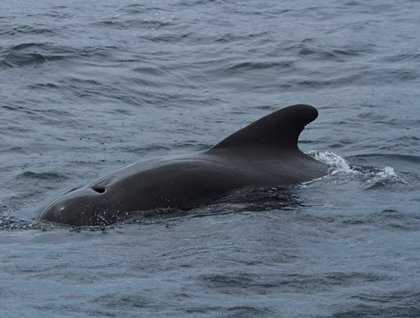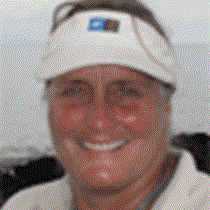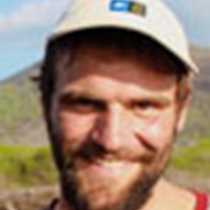We awoke, already in the northern hemisphere for a couple hours now, and found that the first mate was on the bridge and we were navigating along the northern coast of the largest island, Isabela. The sky was grey and cloudy, but the breeze was warm. We gathered on deck to search the skies for birds and the oceans for marine mammals. South of us we could see the dramatic silhouettes of volcanoes Wolf and Ecuador. The sea birds we saw were varied and numerous and included storm petrels, shearwaters, noddy terns, the rare dark-rumped petrels and frigate birds. Several times we saw the big splash as a large mobula ray leapt out of the ocean. There were also several fur seals swimming towards shore, no doubt they were returning from a night of fishing. Our wellness specialist, Maria, led a group of us in yoga stretches and then we enjoyed a delicious and bountiful breakfast.
Afterwards we crowded into the bridge and watched the GPS tick down to 0.00 as we crossed the equator and returned to the southern hemisphere for the remainder of this week’s voyage. Soon Captain Graces dropped the anchor of the National Geographic Islander at Punta Vicente Roca below spectacular steep cliffs that rise 1000 feet straight from the waterline. We all took a wonderful Zodiac cruise along the coast where we spied a variety of wildlife! Huge black marine iguanas rested on the lava boulders and shook their heavy jowls as they defended their territories. Penguins flitted in the shallows chasing tiny fish. We saw our first flightless cormorants; not a particularly handsome bird, but definitely unique! And of course there were sea lions, sally light foot crabs and some of us saw fur seals.
Most of our guests wiggled into their wetsuits and returned to the Zodiacs for deep water snorkeling with Juan Carlos, Walter and I. The conditions were fabulous and this outing was magnificent! We swam among dozens of sea turtles, laughed as speedy penguins darted around us, had a totally fearless young sea lion floating among us, and watched 3 foot long, fast, predatory Sierra mackerel dart in to catch bait fish. Where else, in a short one hour’s outing, can you snorkel with across the orders diversity: fish, mammals (sea lions), flightless birds (penguins and cormorants) and reptiles (many sea turtles and we saw marine iguanas grazing underwater!)?
After our lunch we had planned on a well- deserved siesta, but our second mate, Israel, spotted a pod of pilot whales and I called everyone on deck! We spent 40 minutes alongside them and got amazing views (and hopefully great photos) of the huge male, a dozen females and juveniles, and a really small baby. Then Naturalist Gaby gave us an interesting talk on the human history of these islands. We were soon back in the Zodiacs and headed for the pristine lava shores of Fernandina. This afternoon we watched a hawk feeding on a dead marine iguana, we found a sea turtle sunning on the black sand and we stepped over and around hundreds of marine iguanas. There were baby cormorants in the nests and striated herons fishing. The sun slipped behind the impressive shield volcano of Fernandina, painting the clouds a faint peach color as we motored contentedly back to the ship. We have had an incredibly full and busy day and honestly, I don’t think we can find much that will outshine what we have seen today in las Islas Encantadas!










